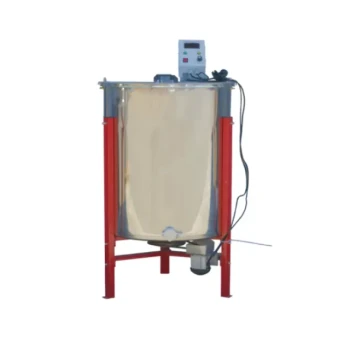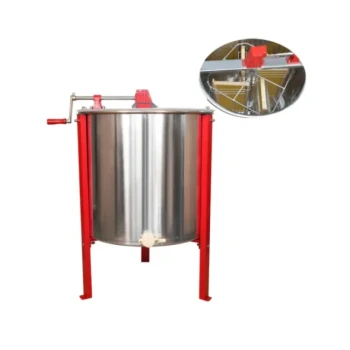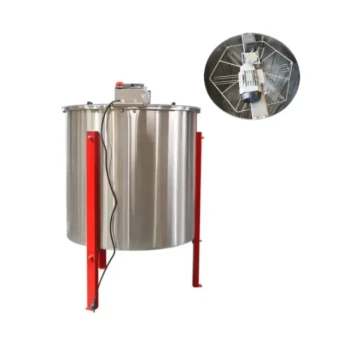The fundamental difference between radial and tangential honey extractors lies entirely in how they position the honey frames inside the drum. A radial extractor arranges frames like spokes on a wheel, using centrifugal force to pull honey from both sides of the comb simultaneously. In contrast, a tangential extractor positions the frame with one side facing the outer wall, requiring you to stop, flip the frame, and repeat the process for the other side.
Your choice between these two designs is not just a technical preference; it's a strategic decision that directly impacts your time, physical effort, and the overall efficiency of your honey harvest.
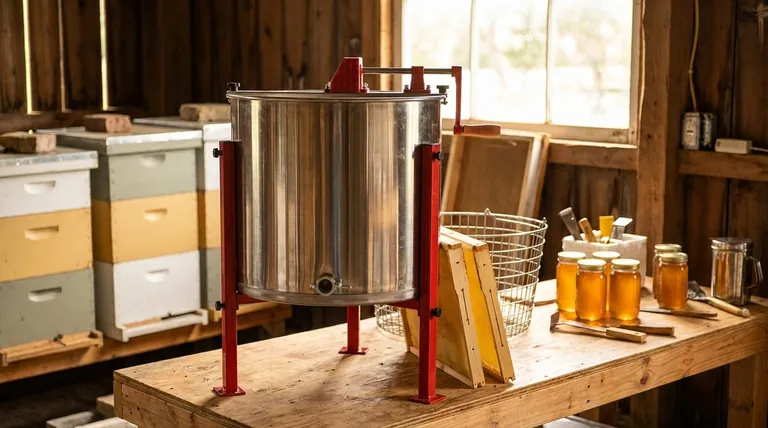
The Mechanics: How Each Type Works
Understanding the core design of each extractor clarifies its specific advantages and disadvantages. The orientation of the frame dictates the entire workflow.
Radial Extractors: The "Spokes on a Wheel" Method
In a radial extractor, frames are placed vertically with their top bars facing outward, like the spokes of a wheel.
When the extractor spins, centrifugal force acts perpendicularly to the comb, pulling honey straight out of the cells from both sides at the same time.
This design is inherently more efficient as it eliminates the need to flip the frames mid-process.
Tangential Extractors: The "One Side at a Time" Method
A tangential extractor holds the frames with one full side of the honeycomb facing the outer wall of the drum.
As it spins, honey is extracted from that outward-facing side only. To harvest the other side, you must stop the machine, manually flip each frame, and then spin it again.
This multi-step process is more labor-intensive and time-consuming.
A Critical Factor: Manual vs. Motorized Power
The distinction between radial and tangential is often linked to the method of power, as the design choice is tied to the intended scale of operation.
Manual (Hand-Crank) Power
Manual extractors are operated by a hand crank. They are simple, require no electricity, and are generally the most affordable option.
This makes them a popular choice for beginner or small-scale beekeepers who don't mind the physical effort and slower processing time.
Electric (Motorized) Power
Electric extractors use a motor to spin the basket, offering consistent speed and significantly reducing manual labor.
They streamline the process, making them ideal for larger-scale or commercial beekeepers who need to process many frames quickly and efficiently.
How Power and Type Intersect
While you can find all combinations, manual extractors are most often tangential, and radial extractors are most often motorized. This is because the efficiency gains of a radial design are best realized with the speed and consistency of a motor.
Understanding the Trade-offs
Choosing an extractor requires balancing three key factors: efficiency, cost, and the scale of your beekeeping operation.
Efficiency and Time
Radial extractors are the clear winner in efficiency. By extracting from both sides at once, they can cut the processing time by more than half compared to the spin-flip-spin process of a tangential extractor.
Cost and Initial Investment
Tangential extractors, particularly manual models, are the most cost-effective entry point. Their simpler design makes them more affordable and accessible for hobbyists who may only have a few hives.
Scale of Operation
The number of hives you manage is the most critical deciding factor. A manual tangential extractor is perfectly adequate for a beekeeper with one to five hives. For anyone with more, the time and labor saved by a motorized radial extractor quickly becomes a necessity.
Making the Right Choice for Your Apiary
Select the tool that best aligns with the current size and future goals of your apiary.
- If your primary focus is hobby beekeeping (1-5 hives): A manual tangential extractor offers the best balance of cost and functionality without over-investing.
- If your primary focus is growing your operation (5-20+ hives): A motorized radial extractor is a worthwhile investment that will save you significant time and physical labor during harvest.
- If your primary focus is maximum efficiency for a commercial scale: An electric radial extractor is the professional standard, designed for high-volume, consistent output.
Ultimately, the best extractor is the one that matches the scale of your passion and the goals of your harvest.
Summary Table:
| Feature | Radial Extractor | Tangential Extractor |
|---|---|---|
| Frame Orientation | Frames like wheel spokes | One side faces the wall |
| Extraction Process | Both sides simultaneously | Spin, flip, then spin again |
| Best For | Efficiency & larger operations (5+ hives) | Cost-effectiveness & small-scale (1-5 hives) |
| Typical Power Source | Often motorized | Often manual |
Ready to Streamline Your Honey Harvest?
Choosing the right extractor is crucial for the efficiency and growth of your apiary. Whether you're a hobbyist or a commercial beekeeper, HONESTBEE supplies the durable, high-performance equipment you need.
We provide wholesale-focused solutions for commercial apiaries and beekeeping equipment distributors. Let us help you select the perfect extractor to save time, reduce labor, and maximize your honey yield.
Contact HONESTBEE today for expert advice and commercial pricing!
Visual Guide
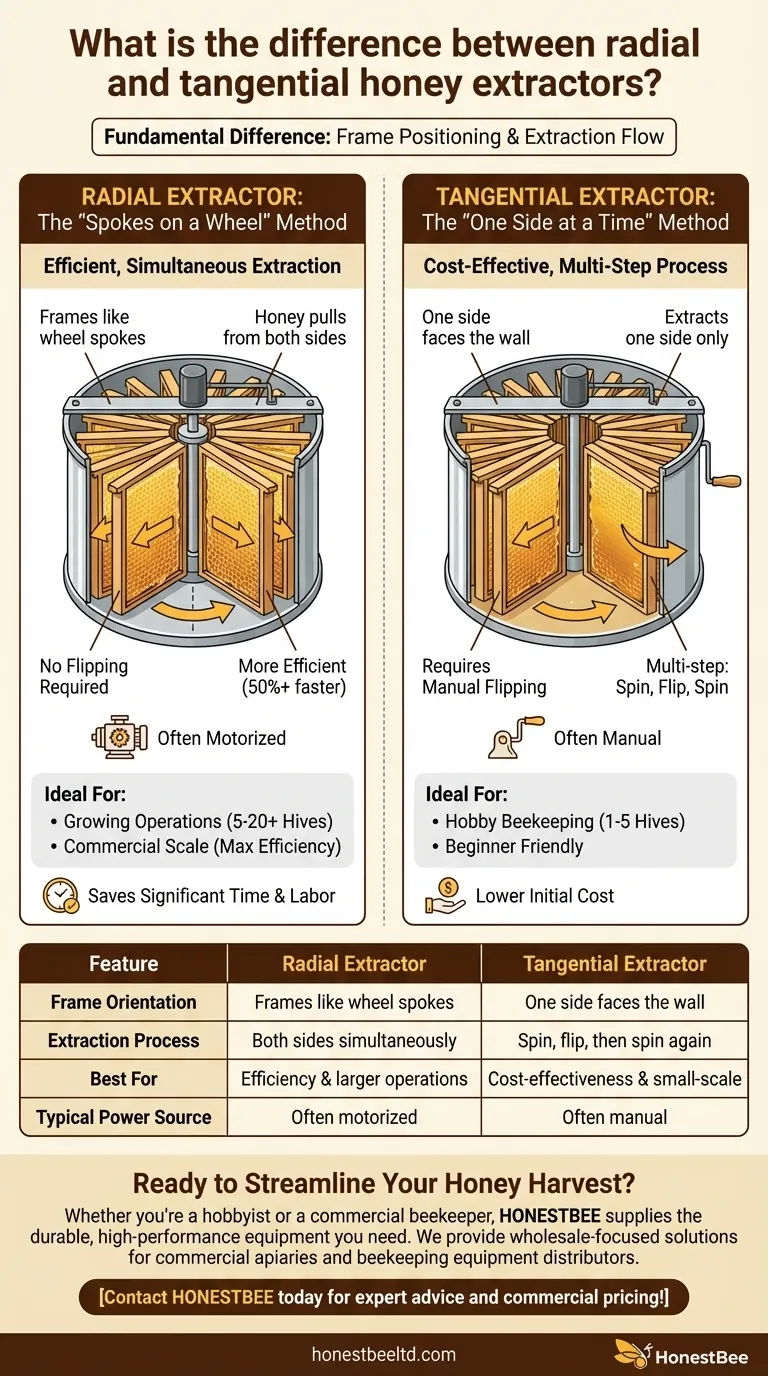
Related Products
- Stainless Steel Manual 8 Frame Radial Honey Extractor Machine for Beehives
- 8-Frame Electric Self-Reversing Honey Extractor Spinner for Commercial Honey Extraction Equipment
- HONESTBEE 72 Frame Industrial Electric Honey Extractor for Beekeeping
- Professional 4 Frame Self Reversing Electric Honey Extractor for Beekeeping
- 2 Frame Stainless Steel Manual Honey Spinner Extractor for Beekeeping
People Also Ask
- What are the advantages of tangential honey extractors? Gentle, Affordable Honey Extraction for Your Apiary
- What is the difference between a radial and tangential honey extractor? Boost Your Harvest Efficiency
- What are the differences between tangential and radial honey extractors? Choose the Right Machine for Your Apiary's Scale
- What is the difference between a radial extractor and a tangential extractor? Choose the Right Extractor for Your Apiary
- What is a tangential extractor and how does it work? A Complete Guide for Hobbyist Beekeepers



